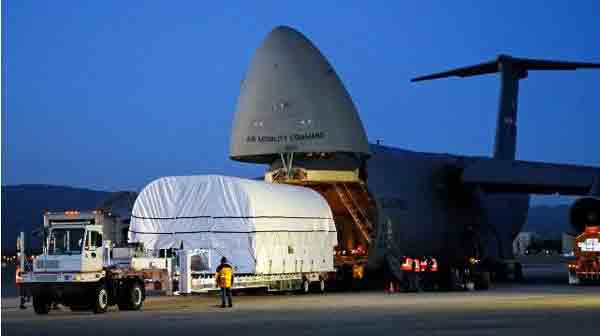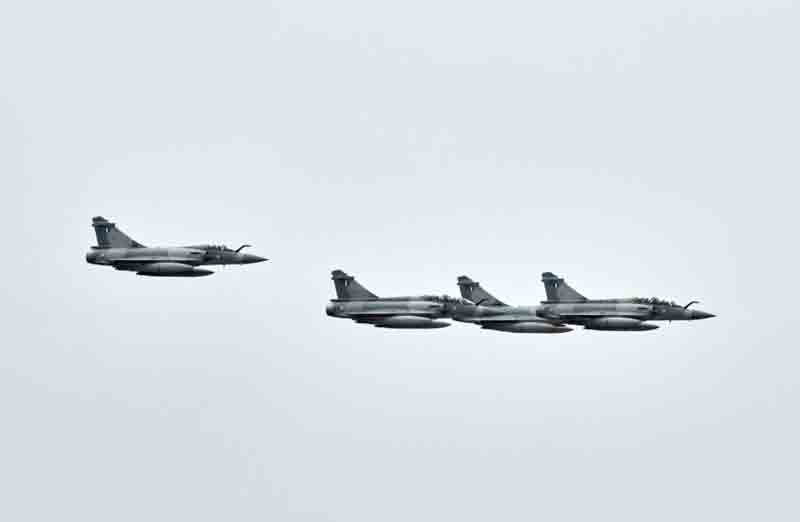On April 5, 2025, a U.S. Air Force C-5M Super Galaxy, recognized as one of the largest military transport aircraft globally, landed at Nevatim Airbase in southern Israel.
This landing, highlighted by the open-source intelligence account OSINTdefender on X, took place close to the location where the U.S. Army’s Terminal High Altitude Area Defense (THAAD) system is stationed in the Negev Desert.
The aircraft, which departed from Ramstein Air Base in Germany, returned to its base after fulfilling its mission, as monitored by Flightradar24. This enormous aircraft, designed to transport heavy military equipment, likely delivered essential supplies related to THAAD or other air defense systems, potentially to restock missiles used in recent interceptions of ballistic threats from Yemen’s Houthi rebels aimed at Israel.
This operation indicates a strengthening of U.S.-Israel military collaboration amid escalating regional tensions, while also prompting inquiries regarding the strategic purpose behind such a prominent logistics mission.
The C-5M Super Galaxy exemplifies cutting-edge engineering, crafted to transport the heaviest and most sensitive military cargo over extensive distances. Manufactured by Lockheed Martin, this strategic airlifter measures 247 feet in length and boasts a wingspan of nearly 223 feet.
Equipped with four General Electric TF39 engines, which have been upgraded in the C-5M variant to the more efficient F138-GE-100, the aircraft generates a total thrust exceeding 200,000 pounds, allowing it to carry a maximum payload of around 281,000 pounds—over 120 tons.
The cargo bay, with dimensions of 121 feet in length, 19 feet in width, and 13.5 feet in height, can hold a variety of items, from tanks and helicopters to sensitive missile defense components. A distinctive feature of the C-5M is its capability to load and unload from both the nose and tail, enhancing its adaptability for swift deployment.
With a range surpassing 5,500 miles and the ability to refuel in midair, this aircraft is a vital component of the U.S. military’s global operational capabilities. The flight from Ramstein to Nevatim, approximately 1,800 miles, is well within its operational range, indicating a meticulously organized mission to transport urgent materials.
The cargo is likely associated with the THAAD system located near Nevatim. Developed by Lockheed Martin, THAAD is a sophisticated anti-ballistic missile defense system designed to intercept short, medium, and intermediate-range ballistic missiles during their terminal phase, either within or just outside the Earth’s atmosphere.
In contrast to conventional missile interceptors that utilize explosive warheads, THAAD employs kinetic energy to eliminate targets by colliding with them at hypersonic speeds. Each battery consists of six truck-mounted launchers, each capable of holding up to eight interceptors, and is supported by the AN/TPY-2 X-band radar, which can detect and track threats from distances of up to 1,000 miles.
This radar, manufactured by Raytheon, is designed for air transport, making it a suitable candidate for delivery via C-5M. However, its initial deployment to Israel in 2008 indicates that this mission was likely aimed at replenishing existing resources rather than establishing new installations.
A single THAAD interceptor has a weight of approximately 2,000 pounds, allowing the C-5M to potentially transport numerous interceptors, along with spare parts or extra launchers, in a single flight. However, transporting such delicate equipment presents challenges; factors like vibration, temperature regulation, and secure handling are essential to ensure the system remains functional upon arrival.
Nevatim Airbase, situated 15 kilometers east-southeast of Beersheba, is a crucial component of Israel’s defense strategy. It hosts the Israeli Air Force’s F-35I Adir stealth fighters, as well as various transport and reconnaissance squadrons. The base features three runways of different lengths, making it well-suited for large aircraft such as the C-5M.
Located in the northern Negev Desert, Nevatim provides strategic advantages by being out of reach of short-range threats from Gaza while still being close enough to facilitate operations throughout Israel’s southern and central areas. The nearby U.S. THAAD deployment further emphasizes Nevatim’s significance as a center for integrated air defense.
The presence of this system bolsters the protection of the F-35I fleet, which has been targeted by Iranian rhetoric following missile strikes on Israeli bases, including Nevatim, in April and October 2024.
Analysis of satellite imagery from these attacks, conducted by sources like The Associated Press, indicated only minor damage to taxiways and hangars, with no aircraft losses—highlighting the effectiveness of the existing layered defenses.
The timing of this delivery reflects a larger operational landscape. In recent months, Yemen’s Houthi rebels, supported by Iran, have intensified their ballistic missile and drone assaults on Israel, often expressing solidarity with Palestinians amid the ongoing conflict in Gaza.
On December 27, 2024, a THAAD battery in Israel successfully intercepted a ballistic missile launched by the Houthis, marking its inaugural combat deployment in the region, as reported by the U.S. Department of Defense. Each successful interception reduces the limited supply of interceptors, which are valued at around $12 million each.
With Iran’s proxies, such as Hezbollah in Lebanon and various groups in Syria, posing ongoing ballistic threats, both the U.S. and Israel seem to be preparing for prolonged challenges. The arrival of the C-5M may indicate a reaction to recent military expenditures or a proactive buildup in anticipation of potential escalations.
Earlier this year, Iran’s missile strikes on Nevatim—recording over 30 impacts in October, according to NPR—highlighted the vulnerabilities even well-protected bases can face, although damage was mitigated by Israel’s Arrow defense system and allied support.
This operation is part of a long-standing history of military cooperation between the U.S. and Israel, while also showcasing a shifting strategic landscape. The initial deployment of THAAD to Israel took place in March 2019 during a joint exercise, which integrated the system with Israel’s Arrow and Iron Dome defense systems.
That exercise, conducted by the U.S. Army Europe’s 10th Air and Missile Defense Command, tested the rapid deployment capabilities from Fort Bliss, Texas, to Nevatim using C-17 Globemaster aircraft—a smaller variant of the C-5M. The drill validated the concept of quickly mobilizing U.S. resources to enhance Israeli defenses, a capability that is now actively utilized.
Ramstein Air Base, the launch point for the C-5M, has historically functioned as a key staging area for military operations, thanks to its advantageous location in Germany that allows for rapid access to the Middle East. There are notable historical precedents, such as the THAAD deployments to South Korea in 2017 and the UAE in 2022, which were responses to similar ballistic threats posed by North Korea and the Houthis, respectively.
The extensive role of the C-5M suggests a transition towards more agile and resilient logistics, addressing a region where threats are escalating more quickly than permanent defenses can be established.
What additional cargo might the C-5M have transported? While THAAD is the primary focus, the aircraft’s substantial capacity invites speculation based on Pentagon activities. It is possible that spare parts for the AN/TPY-2 radar, operational in Israel since 2008, were included to ensure its optimal functionality.
Additionally, components for other systems, such as the Patriot missile system—which Israel is gradually retiring but still utilizes—could have been part of the shipment. This is particularly relevant in light of reports from The Aviationist in January 2025, indicating that Israel transferred decommissioned Patriot missiles to Ukraine via Ramstein.
There is also the possibility that intelligence-gathering equipment, including sensors designed to track Iranian missile advancements, was included in the cargo, although no public evidence supports this claim. The Pentagon’s usual discretion regarding mission specifics adds to the intrigue surrounding whether this delivery serves a broader, undisclosed objective—potentially in preparation for an expanded confrontation with Iran, whose missile program is progressing with developments like the Fattah-1, which is said to evade THAAD-class defenses.
When comparing the C-5M and THAAD to their global counterparts, their distinct roles become evident. Russia’s An-124 Ruslan, a competing heavy-lift aircraft, can carry a slightly greater payload of 150 tons but lacks the midair refueling capability of the C-5M, which limits its strategic versatility.
China’s Y-20 is gaining recognition, yet it has a maximum capacity of 66 tons, which is less than half that of the C-5M. In terms of missile defense, Russia’s S-400 can target ballistic threats but does not match the high-altitude, kinetic-kill accuracy of THAAD, as it relies on explosive warheads with a limited interception range.
Iran’s Bavar-373, presented as a rival to THAAD, has yet to prove itself in combat, and its asserted range of 200 kilometers is significantly less than THAAD’s radar capabilities. These differences highlight the reasons the U.S. and Israel depend on their integrated systems, which merge American resources with Israeli responsiveness to address a complex array of threats.
The C-5M’s arrival at Nevatim is more than a logistical detail; it illustrates the evolution of modern aerial warfare. The aircraft’s capacity to transport THAAD components within hours instead of weeks demonstrates the urgency needed to respond to rapidly changing conflicts.
Historically, airlift operations have been pivotal during crises—the Berlin Airlift of 1948-49 sustained a city, while the airlift during the Yom Kippur War in 1973 provided Israel with essential U.S. supplies.
This legacy persists today, emphasizing precision and deterrence. Data from Flightradar24, which tracks the C-5M’s direct flight from Ramstein to Nevatim and back, offers a rare public insight into this operation, although the complete details remain classified. For the U.S., each THAAD interceptor represents a $1 billion system that is in limited supply—only eight batteries are currently operational worldwide, with a ninth expected in 2025, according to Lockheed Martin.
Looking forward, this mission could subtly yet significantly influence dynamics in the Middle East. If it successfully replenishes THAAD inventories, it would enhance Israel’s position against Iran and its affiliates, potentially deterring future aggressions.
Should this indicate a larger accumulation, it could suggest a shift in U.S. asset positioning as tensions with Iran escalate. This partnership also emphasizes a message of solidarity amid increasing domestic discussions regarding U.S. foreign obligations. However, the operation prompts an important inquiry: Is this merely a standard resupply, or the initial step in a more extensive strategic maneuver?
At this moment, the presence of the C-5M on Nevatim’s runway provides a rare glimpse of clarity in a conflict that is otherwise shrouded in ambiguity—where technology, strategy, and alliances intersect beneath the desert sky.
Discover more from Defence Talks | Defense News Hub, Military Updates, Security Insights
Subscribe to get the latest posts sent to your email.





